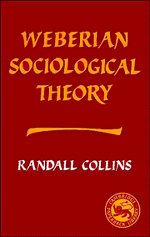Summary
This book represents an effort to demonstrate that Weberian sociology is intellectually alive, in at least as full a sense as Marxian sociology is alive today. By this I mean not only that Max Weber's works are a landmark in the history of our discipline but also that in many respects his ideas still mark the frontier of our knowledge. This is particularly true in the areas of macrosociology: politics, economics, large-scale stratification patterns, and above all in the megasociology of long-term historical change. At the same time, I am no believer in the excessive adulation of past theorists, no matter how heroic. The best way to demonstrate the vitality of Weber's theories is to show they are capable of projection beyond themselves. That is what this book attempts to do.
Weber was an extraordinarily multisided figure, and I do not claim to develop more than a few sides of his approach. I have acquired some appreciation for what Weber's various sides have included, or at least engendered, from my teachers of some years past Talcott Parsons and Reinhard Bendix. Various parts of this book have benefited from comments or other assistance by Samuel W. Kaplan, Vatro Murvar, Stephen Kalberg, Guenther Roth, Walter Goldfrank, Norbert Wiley, Whitney Pope, Al Bergesen, Immanuel Wallerstein, Wolfram Eberhard, Jack Goldstone, Paul DiMaggio, Ken Donow, Craig Calhoun, Robert L. Hamblin, Michael Hout, Arthur L. Stinchcombe, Rae Lesser Blumberg, Richard Gordon, Melvin Seeman, Roy d'Andrade, and Victor Zaslavsky.
- Type
- Chapter
- Information
- Weberian Sociological Theory , pp. xi - xiiPublisher: Cambridge University PressPrint publication year: 1986

